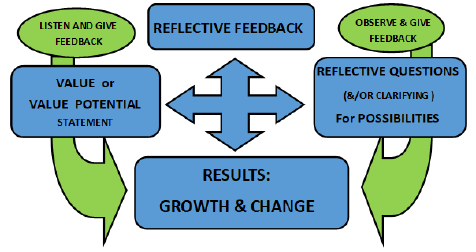Reflective Feedback
Key Concepts & Ideas
- Reflective Feedback is aligned with the most current research from neuroscience, Gallup, motivation theory and trust research.
- Giving feedback is the primary responsibility of leaders.
- To have the most value for change—it is important that feedback is received without a sense of threat.
- Feedback MUST promote thinking SELF-DIRECTED learning.
- Feedback must be specific & align with expectations for performance.
REFLECTIVE FEEDBACK – Keys or Locks?
Research at Harvard and the NeuroLeadership Institute has been clear for quite some time. Feedback is essential for growth and development both for individuals and for organizations. The sad news is that most feedback fails to yield more than little to no change. Locks.. mostly because it comes with an attitude, a tone, words full of judgment or blame or without really saying much of anything. Corporate America is working hard to change the way we give feedback in a way that ultimately will have people asking for it; maybe not in the near future, but certainly the ultimate goal.
If you believe criticism is good, helps us perform better, consider some research that shows that employees reacted positively to criticism just one out of thirteen times. David Rock, author of Quiet Leader, number other leadership books and founder of the NeuroLeadership Institute says, “people get, on average a couple of minutes of positive feedback every year versus thousands of hours of negative feedback-Locks few Keys.”
“If you treat an individual as he is, he will stay as he is, but if you treat him as if he were what he ought to be and could be, he will become what he ought and could be.” Goethe
Remember the iceberg metaphor? Our behaviors are driven by our emotions which are driven by our thinking. So our thinking is at the core of our performance. We know today that people’s fear, imagining the worst, and self-doubt get in the way of their performance. Our inner voice can stifle our performance. When we experience anxiety, fear, self-consciousness, or any strong emotion, our neurons get flooded with electrical signals—we literally stop hearing and sometimes even seeing what’s around us. Locks. If we want to transform people’s performance, we must master the skill of acknowledgment — which means building new wiring around seeing what people are doing well. A new approach is essential. Keys. A new set of questions might sound like this:
- What are you doing well and what are you discovering about yourself as a result?
- What are the highlights of this project and what are you learning?
- What is going well, and what would you like to do more?
- What are you doing well, and how are you impacting everyone else?
To transform performance requires providing continuous positive feedback, in many forms, over time — to validate, confirm, encourage, support, and believe in people’s potential. Keys
Results Coaching provides two easy ways to provide powerful reflective and positive feedback. Ken Blanchard of the One Minute Manager says to catch people doing things right. Sounds so easy, it’s hard to do. We can learn new patterns. Whether you are listening to someone or you want feedback, the steps are the same, AND they will produce GROWTH & CHANGE. Keys!
Step 1: See what is working, what is good, positive or has potential. Offer a VALUE statement or VALUE POTENTIAL statement. “Wow, Sam, what an effective way you worked with your class for deep learning today. Kids had choices, they were working in small groups talking about the water cycle and they were making connections to their lives out of school.”
Step 2: Ask a REFLECTIVE QUESTION for Possibility (a question that presumes positive intent, can’t be answered with yes or no. That will push thinking — and can be embedded in a standard or expectation.)
REFLECTIVE FEEDBACK PROTOCOL: LISTEN & GIVE FEEDBACK
Introduction:
- Purpose: To practice giving a reflective question to each person in the small group
- Organize participants into groups of 5-6
- Each round is 10 or 15 minutes (time might be varied on group size)
- Each group designated a timekeeper
- Depending on the remaining time after the feedback, the speaker will respond to the clarifying/reflective questions.
Step 1: GOAL CLARITY (3 minutes) Person #1 begins by:
- Sharing a work goal, something they are currently working on.
- Describing why this is important right now
- Describing what they have done towards this goal so far
- Ask what feedback they desire from this opportunity.
Step 2: TEAM FEEDBACK (one minute, per person, each member of the team offers:
- 2 Value/Value Potential statements
- 1 Reflective question for possibility, including any clarifying question
NOTE: All value/value potential statements are shared before asking a clarifying or reflective question.
NOTE: NO CROSS TALK
Step 3: SPEAKER RESPONSE (given remaining time)
- Reflective questions may be answered.
- The speaker reflects on the feedback, takeaways, and possible next steps.
ROUND 2 moves to the next person until everyone in the group have had an opportunity to give and receive feedback.



THE GOOD NEWS: Feedback is essential for individual, community, and organizational effectiveness and learning
THE BAD NEWS: Feedback often flops, yielding no meaningful exchange of information and driving people apart.
